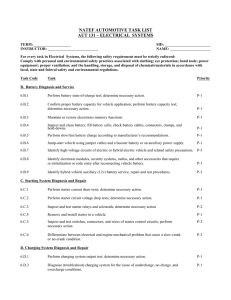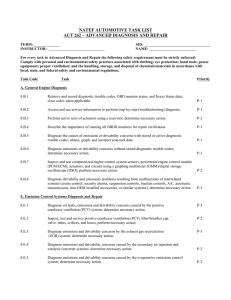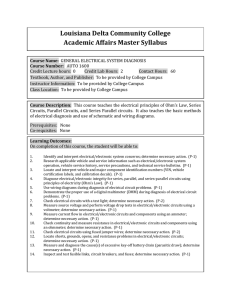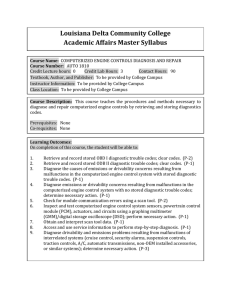At – A Glance
advertisement
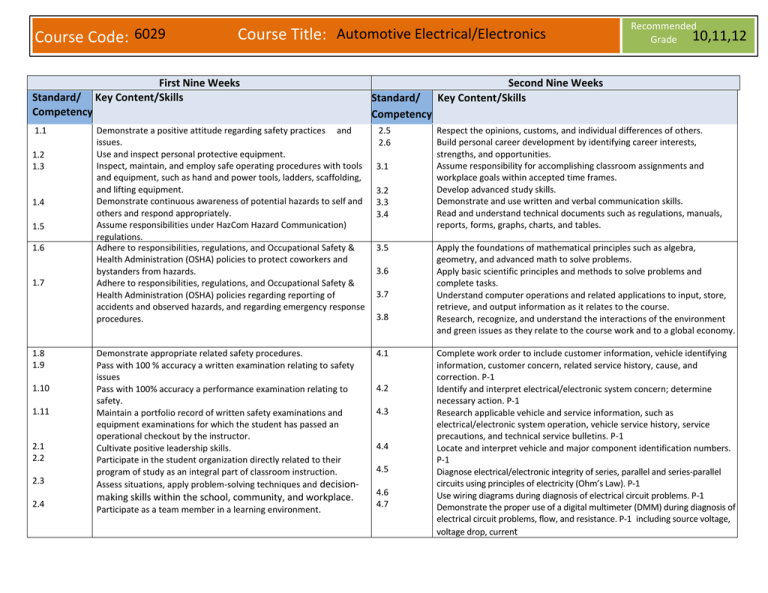
Course Code: 6029 Standard/ Competency 1.1 1.2 1.3 1.4 1.5 1.6 1.7 1.8 1.9 1.10 1.11 2.1 2.2 2.3 2.4 Course Title: Automotive Electrical/Electronics First Nine Weeks Key Content/Skills Demonstrate a positive attitude regarding safety practices and issues. Use and inspect personal protective equipment. Inspect, maintain, and employ safe operating procedures with tools and equipment, such as hand and power tools, ladders, scaffolding, and lifting equipment. Demonstrate continuous awareness of potential hazards to self and others and respond appropriately. Assume responsibilities under HazCom Hazard Communication) regulations. Adhere to responsibilities, regulations, and Occupational Safety & Health Administration (OSHA) policies to protect coworkers and bystanders from hazards. Adhere to responsibilities, regulations, and Occupational Safety & Health Administration (OSHA) policies regarding reporting of accidents and observed hazards, and regarding emergency response procedures. Demonstrate appropriate related safety procedures. Pass with 100 % accuracy a written examination relating to safety issues Pass with 100% accuracy a performance examination relating to safety. Maintain a portfolio record of written safety examinations and equipment examinations for which the student has passed an operational checkout by the instructor. Cultivate positive leadership skills. Participate in the student organization directly related to their program of study as an integral part of classroom instruction. Assess situations, apply problem-solving techniques and decision- making skills within the school, community, and workplace. Participate as a team member in a learning environment. Standard/ Competency 2.5 2.6 3.1 3.2 3.3 3.4 3.5 3.6 3.7 3.8 4.1 4.2 4.3 4.4 4.5 4.6 4.7 Recommended Grade 10,11,12 Second Nine Weeks Key Content/Skills Respect the opinions, customs, and individual differences of others. Build personal career development by identifying career interests, strengths, and opportunities. Assume responsibility for accomplishing classroom assignments and workplace goals within accepted time frames. Develop advanced study skills. Demonstrate and use written and verbal communication skills. Read and understand technical documents such as regulations, manuals, reports, forms, graphs, charts, and tables. Apply the foundations of mathematical principles such as algebra, geometry, and advanced math to solve problems. Apply basic scientific principles and methods to solve problems and complete tasks. Understand computer operations and related applications to input, store, retrieve, and output information as it relates to the course. Research, recognize, and understand the interactions of the environment and green issues as they relate to the course work and to a global economy. Complete work order to include customer information, vehicle identifying information, customer concern, related service history, cause, and correction. P-1 Identify and interpret electrical/electronic system concern; determine necessary action. P-1 Research applicable vehicle and service information, such as electrical/electronic system operation, vehicle service history, service precautions, and technical service bulletins. P-1 Locate and interpret vehicle and major component identification numbers. P-1 Diagnose electrical/electronic integrity of series, parallel and series-parallel circuits using principles of electricity (Ohm’s Law). P-1 Use wiring diagrams during diagnosis of electrical circuit problems. P-1 Demonstrate the proper use of a digital multimeter (DMM) during diagnosis of electrical circuit problems, flow, and resistance. P-1 including source voltage, voltage drop, current Course Code: 6029 Standard/ Competency 4.8 4.9 4.10 4.11 4.12 4.13 4.14 4.15 4.16 4.17 4.18 5.1 5.2 5.3 5.4 5.5 5.6 5.7 5.8 5.9 Course Title: Automotive Electrical/Electronics Third Nine Weeks Key Content/Skills Standard/ Competency Check electrical circuits with a test light; determine necessary action. P-2 Check electrical/electronic circuit waveforms; interpret readings and determine needed repairs. P-2 Check electrical circuits using fused jumper wires; determine necessary action. P-2 Locate shorts, grounds, opens, and resistance problems in electrical/electronic circuits; determine necessary action. P-1 Measure and diagnose the cause(s) of excessive parasitic draw; determine necessary action. P-1 Inspect and test fusible links, circuit breakers, and fuses; determine necessary action. P-1 Inspect and test switches, connectors, relays, solenoid solid state devices, and wires of electrical/electronic circuits; perform necessary action. P-1 Remove and replace terminal end from connector; replace connectors and terminal ends. P-1 Repair wiring harness (including CAN/BUS systems). P-1 Perform solder repair of electrical wiring. P-1 Identify location of hybrid vehicle high voltage circuit disconnect (service plug) location and safety procedures. P-2 6.1 6.2 Perform battery state-of-charge test; determine necessary action. P-1 Perform battery capacity test; confirm proper battery capacity for vehicle application; determine necessary action. P-1 Maintain and restore electronic memory functions. P-1 Inspect, clean, fill, and /or replace battery. P-1 Perform slow battery charge. P-1 Start a vehicle using jumper cables or an auxiliary power supply. P-1 Identify high voltage circuits of electric or hybrid electric vehicle and related safety precautions. P-1 Identify electronic modules, security systems, radios, and other accessories that require reinitialization or code entry following battery disconnect. P-1 Identify hybrid vehicle auxiliary (12v) battery service, repair and test procedures. P-3 8.3 6.3 6.4 6.5 6.6 7.1 7.2 7.3 7.4 7.5 8.1 8.2 8.4 9.1 9.2 9.3 9.4 10.1 10.2 Recommended Grade 10,11,12 Fourth Nine Weeks Key Content/Skills Perform starter current draw tests; determine necessary action. P-1 Perform starter circuit voltage drop tests; determine necessary action. P1 Inspect and test starter relays and solenoids; determine necessary action. P-2 Remove and install starter in a vehicle. P-1 Inspect and test switches, connectors, and wires of starter control circuits; perform necessary action. P-2 Differentiate between electrical and engine mechanical problems that cause a slow-crank or no-crank condition. P-2 Perform charging system output test; determine necessary action. P-1 Diagnose charging system for cause of undercharge, no-charge, and overcharge conditions. P-1 Inspect, adjust, or replace generator (alternator) drive belts, pulleys, and tensioners; check pulley and belt alignment. P-1 Remove, inspect, and install generator (alternator). P-1 Perform charging circuit voltage drop tests; determine necessary action. P-1 Diagnose the cause of brighter than normal, intermittent, dim, or no light operation; determine necessary action. P-1 Remove, inspect, and install headlights and bulbs. P-2 Inspect and diagnose incorrect turn signal or hazard light operation; perform necessary action. P-2 Identify system voltage and safety precautions associated with high intensity discharge headlights. P-2 Inspect and test gauges and gauge sending units for cause of abnormal gauge readings; determine necessary action. P-1 Inspect and test connectors, wires, and printed circuit boards of gauge circuits; determine necessary action. P-3 Diagnoses the cause of incorrect operation of warning devices and other driver information systems; determines necessary action. Inspects and tests sensors, connectors, and wires of electronic (digital) instrument circuits; determines necessary action. Diagnose incorrect horn operation; determine necessary action. P-1 Diagnose incorrect wiper operation; diagnose wiper speed control and park problems; perform necessary action. P-1 Course Code: 6029 Standard/ Competency Course Title: Automotive Electrical/Electronics Third Nine Weeks Key Content/Skills Standard/ Competency 10.3 11.1 11.2 11.3 11.4 11.5 11.6 11.7 11.8 11.9 11.10 11.11 11.12 11.13 Recommended Grade 10,11,12 Fourth Nine Weeks Key Content/Skills Diagnose incorrect washer operation; perform necessary action. P-2 Diagnose incorrect operation of motor driven accessory circuits; determine necessary action. P-1 Diagnose incorrect heated glass, mirror, or seat operation; determine necessary action. P-3 Diagnose incorrect electric clock operation; determine necessary action. P-1 Diagnose incorrect operation of cruise control systems; determine necessary action. P-3 Diagnose supplemental restraint system (SRS) concerns; determine necessary action. P-1 Disarm and enable airbag system for vehicle service. P-1 Diagnose radio static and weak, intermittent, or no radio reception; determine necessary action. P-3 Remove and reinstall door panel. P-1 Diagnose body electronic system circuits using a scan tool; determine necessary action. P-2 Check for module communication (including CAN/BUS systems) errors using a scan tool. P-2 Diagnose the cause of false, intermittent, or no operation of anti-theft systems. P-3 Describe the operation of keyless entry/remote start systems. P-3 Perform software transfers, software updates, or flash reprogramming on electronic modules. P-3


